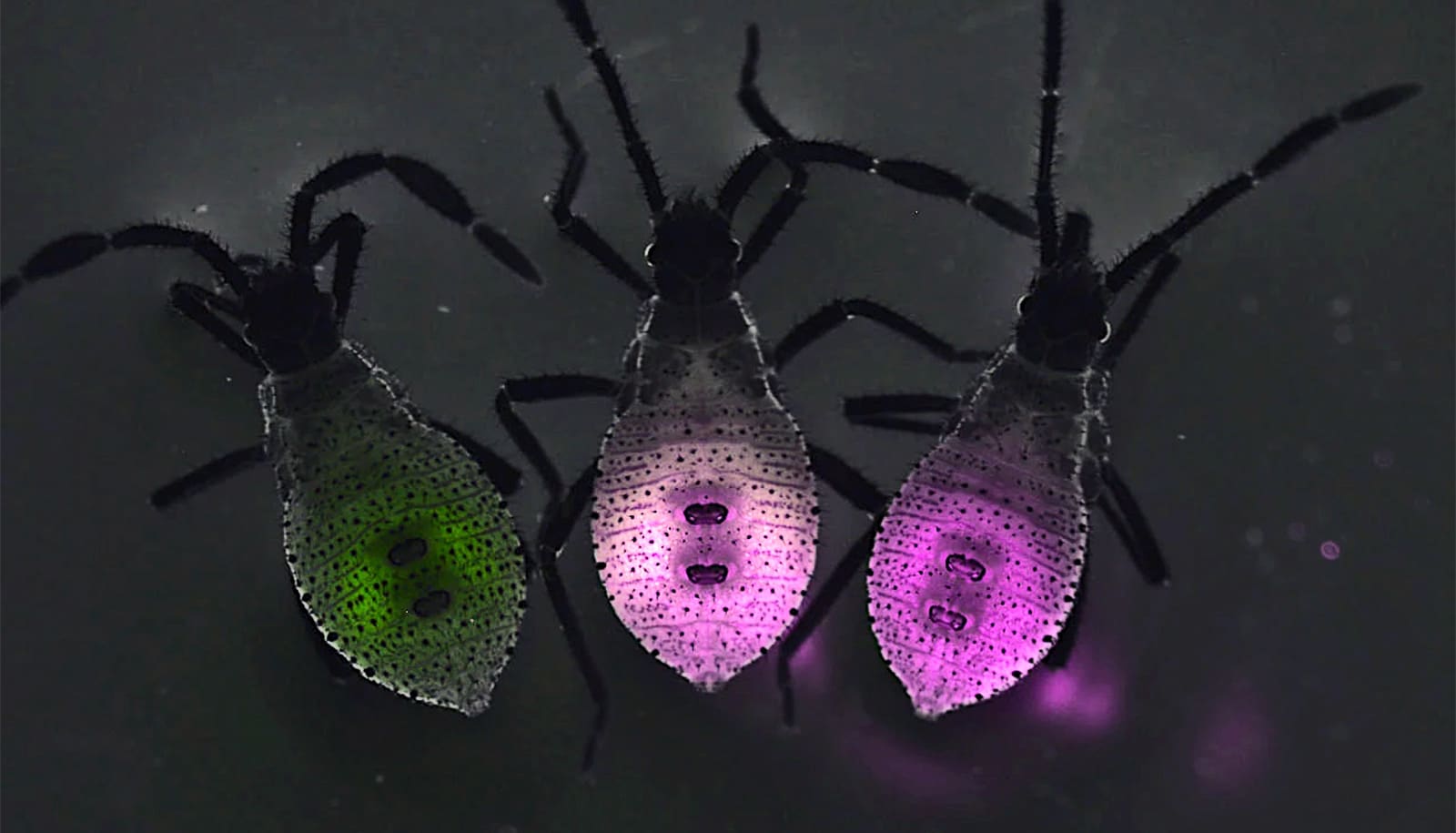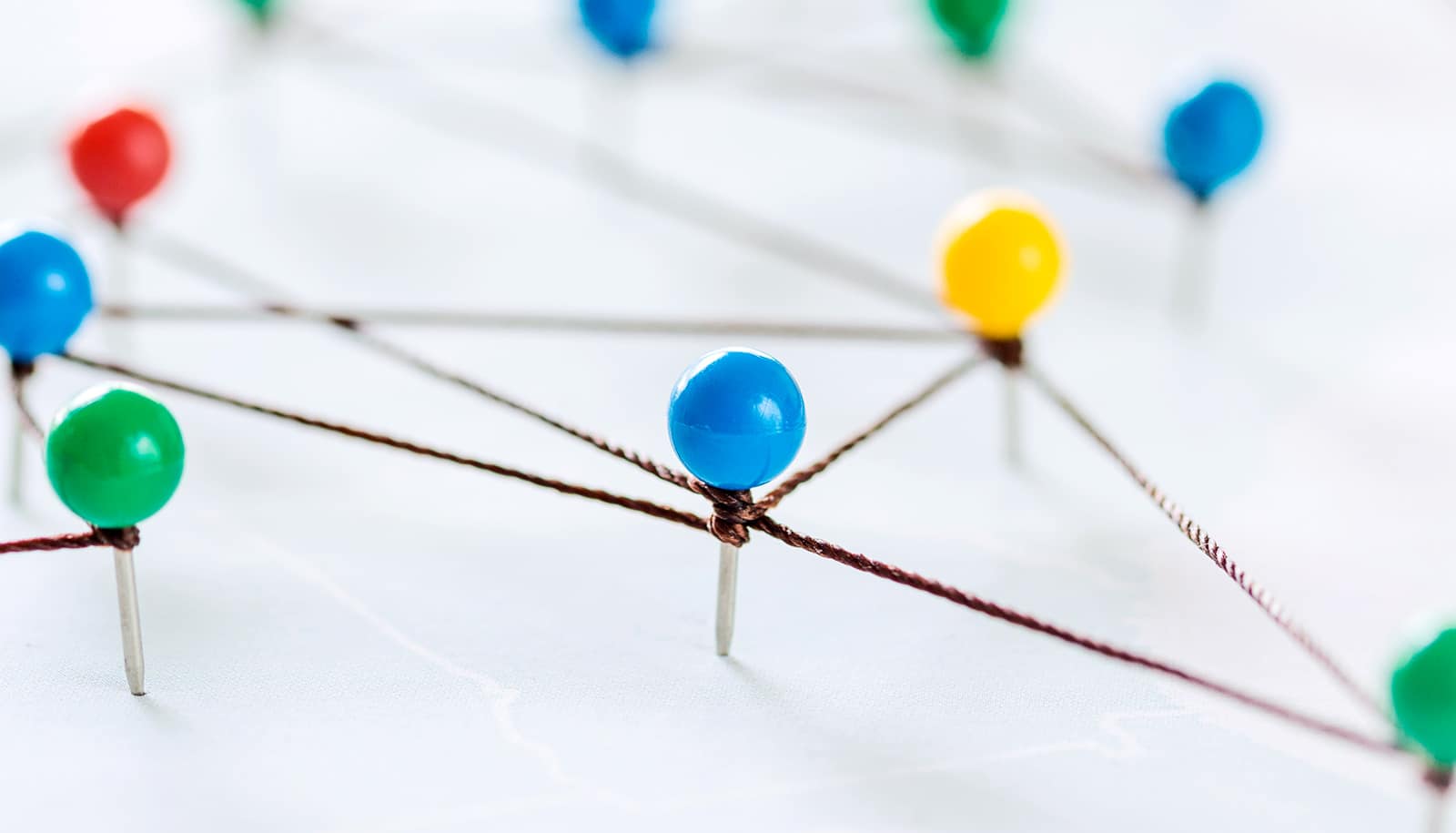
Tagging different strains of bacteria in different fluorescent colors allows the researchers to determine what strain an insect carries in its gut. (Credit: Jason Chen/Emory)
Why young squash bugs must eat poop
Squash bugs carry a gut bacterium that's key to their development into adults, but don't have it as nymphs. New findings reveal how they get it.
Squash bugs carry a gut bacterium that’s essential for their development into adults, but don’t have it as nymphs. New findings indicate how they acquire the essential microbes.
Jason Chen, a graduate student in the Emory University biology department, stumbled upon a clue one evening in the lab.
He had finished up experiments on some adult squash bugs whose Caballeronia bacteria he had tagged with a red fluorescent protein. The bugs were housed in a plastic box with pieces of paper towel inside as bedding. He tossed some nymphs inside the container just as a place to hold them while he cleaned up for the day.
“When I came back to turn the lights out, I noticed that all the nymphs had flocked around one of the poop spots left on a paper towel by the adults,” Chen says. “Normally nymphs wander around a lot, but they had all stopped around this poop. They were transfixed by it. I wondered what that behavior meant.”
He eventually checked the nymphs under a microscope and saw that their guts lit up with the same red fluorescence as the adults. More experiments confirmed the finding—nymph squash bugs eat the feces of adults to acquire the bacteria they need to grow.
Current Biology has published a paper on the discovery, which may offer insights for improved methods to control the squash bug, a significant agricultural pest.
“The squash bug is an example of a plain, ordinary looking animal that actually does something really cool,” says Chen. “When they hatch, the nymphs have to find a microbe in order to develop. They find it by honing in on feces of adults of their same species. It’s an elegant solution for this very basic problem.”
“A lot of children go through a phase where they like to play with insects,” Chen says. “The joke among entomologists is that we never grew out of it. I now work more with the bacteria inside the insects, which is an interesting twist.”
Chen now draws from the expertise of two advisors, who are both senior authors of the Current Biology paper. Nic Vega, assistant professor of biology, focuses on how microbes form complex communities. Nicole Gerardo, professor of biology, studies the evolution of host-microbe interactions, particularly within insects.
“Symbiont” is the term used to refer to a smaller organism that lives in symbiosis with a larger one. Humans teem with hundreds of billions to trillions of symbionts, mainly bacteria, that live on and within the body. Some members of this invisible community, known as “the microbiome,” can have a negative effect on a person’s health. But other microbes benefit their human hosts by helping their immune systems develop, aiding in their digestion and producing energy. Differences in each individual person’s microbiome may even determine their susceptibility to certain illnesses.
Research has already uncovered many mysteries surrounding the human microbiome but big questions remain about the effects of symbionts on human health. Insects have far less complex microbiomes than humans, making them ideal laboratory models to study fundamental questions underlying host-microbe interactions.
Squash bug spit
The squash bug is a flat, grayish-brown insect that resembles its close relatives, the stink bugs.
“Anyone who has ever planted squash in their garden has probably seen this bug,” Chen says. “It’s very good at finding squash plants.”
The squash bug is a “true bug,” meaning that it survives on a liquid diet. It uses a piercing, straw-like mouthpart to stab a plant and inject its saliva into it. The saliva breaks down the plant tissues, liquifying them so that the bug can suck them up.
While squash and pumpkin plants are their main targets, the insects can infest crops of other members of the gourd family, including cucumbers, cantaloupes, and watermelons. In addition to causing direct damage to plants, they can spread a pathogen among crops that causes yellow vine disease.
Armor helps protect squash bugs from getting “squashed.” They emit a noxious smell to further deter predators. And their habit of staying sheltered under leaves limits the impact of pesticides.
“Squash bugs are difficult to control unless you pick them one by one off your plants,” Chen says.
Bug behavior
For his dissertation, Chen is researching variation in microbiomes and how this variation emerges as a result of chance.
To conduct experiments with squash bugs, he genetically modifies strains of the Caballeronia bacteria. He tags the strains with different colors of fluorescent proteins that glow under a microscope.
He had noticed that squash bug nymphs tend to wander continuously, probing the environment with their mouthparts. It caught his eye when he saw them stopped around a spot of adult feces.
“When I see something unusual I immediately write it down in my lab book and take pictures,” Chen says. “That’s what’s great about having a cell phone. A scientist’s phone is always loaded with pictures of whatever they’re doing in the lab.”
To investigate further, Chen teamed with Scott Villa, a behavioral ecologist.
“We brought together the microbiology and behavioral aspects,” Chen explains. “That allowed us to fit all of the puzzle pieces together.”
The paper’s coauthors, former undergraduates Alice Acosta and Zeeyong Kwong, conducted experiments designed by Villa and Chen to test various hypotheses.
The results show that the nymphs would choose to eat adult feces loaded with bacteria over a saline solution or a piece of squash. The nymphs pierce the solid fecal material just as they would plant tissue. They inject their saliva to liquify the feces, then slurp it up.
The researchers presented the nymphs with feces sterilized under high heat and pressure. The bugs still showed a preference for the feces over a saline solution or squash, even though the feces no longer contained live bacteria.
The researchers clipped off part of the nymphs’ antennae with chemical “smell” receptors. That only slightly reduced their attraction to the feces.
“They’re probably using multiple sensory cues to help them find the source of the bacteria,” Chen says. “Smell, sight, taste, and even social cues of what the other bugs are doing.”
Back to squash
Experiments were also conducted using two different species of adult squash bugs infected with two different strains of the bacteria. Nymphs only acquired symbionts from feces of their own species. And they were most successful at acquiring the bacteria specialized to their species, even though either strain would benefit their development.
The nymphs continued to seek out and consume the adult feces until they became infected with the bacteria. At that point, they switched to showing a preference for feeding on squash.
The attraction to the bacteria is so strong that the bugs begin looking for it immediately after they molt to their second stage. They can become infected by eating adult feces within hours, at which point they stop the unusual feeding behavior.
“It’s a very transient behavior that no one was looking for,” Chen says. “And what you don’t look for is easy to miss.”
The discovery of how the bacteria is transmitted opens the door for potential pesticide-free strategies to prevent the insects from devastating agricultural crops. “Now we can consider ways to possibly manipulate this weak point in their system,” Chen says.
Such insights also add to the accumulating knowledge of how organisms and their symbionts evolve and interact.
“Our findings are a cool bit of natural history that was overlooked for a long time,” Chen says. “That’s what gets me out of bed in the morning—the motivation to learn more about how the natural world works.”
Funding came from the US Department of Agriculture.
Source: Emory University
The post Why young squash bugs must eat poop appeared first on Futurity .
Share this article:
This article uses material from the Futurity article, and is licenced under a CC BY-SA 4.0 International License. Images, videos and audio are available under their respective licenses.


